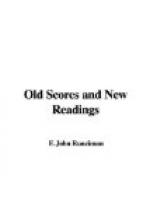cutting his teeth, and not his wisdom teeth.
One finds it difficult to understand how ever the
thing came to be tolerated by musicians. Of course
the desire to find a counter-blast to Wagner has done
much for Verdi; but while one can understand how Dr.
Stanford and others hoped to sweep away “Parsifal”
with “Otello” and “Falstaff,”
it is not so easy to see what on earth they proposed
to do with “Traviata.” It won fame
and cash for its composer in the old days when people
went to the opera for lack of the music-hall, not
yet invented; when Costa still lorded it not over
living musical London merely, but over all the deceased
masters, and without compunction added trombones to
Mozart’s scores, and defiled every masterwork
he touched with his unspeakable Costamongery; when
Wagner was either unheard of or regarded as a dangerous
lunatic and immoral person; and it shows every sign
of having been written to please the opera-goers of
those days. Curiously, the critics of the time,
in the words of the “Daily Telegraph,”
saw in “the Bayreuth master another form of
Bunyan’s man with the muck-rake,” who “never
sought to disguise the garbage he found in the Newgate
Calendar of Mythland, or set his imagination to invent,”
and they were disgusted, also like the “Daily
Telegraph,” by “approaching incest”
in “The Valkyrie”; yet they saw no harm
whatever in the charming story of “Traviata”—the
story of a harlot who reforms to the extent of retaining
only one lover of her many, and who dies of consumption
when that one’s father does his best to drive
her out upon the streets again by making her give
up his son. Far from condemning the story myself,
I am glad Verdi or his employers had the courage to
go boldly to Dumas for it; only, let us be cautious
how we condemn the morality of other opera-stories
while praising the immorality of this. Let us
see how Verdi has handled it. The opera is built
after the same hybrid model as Gounod’s “Romeo”;
it is neither frankly the old Italian opera, existing
for the sake of its songs, nor the later form in which
the songs exist for the sake of the drama, but an attempt
to combine the songs with the continuous working out
of a dramatic impulse in the modern manner. But
the attempt is far less successful than in “Romeo”;
and indeed it is a faint-hearted one. Whenever
a song occurs, the action is suspended, and all the
actors save the lucky vocalist of the minute are at
their wits’ end to know where to look, and what
to do with their hands, feet—their whole
persons in fact—and the parts they are
playing. And the songs are far from being expressive
of the feeling of the situation that is supposed to
call them up. The drinking tune in the first
act is lively and appropriate enough; and not much
more can be said against Violetta’s song, “Ah!
fors’ e lui,” than that while rather pretty
its endless cadenzas are more than rather absurd.
But in the next act Alfredo sings of the dream of his
life to a pretty melody until he is interrupted by




